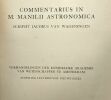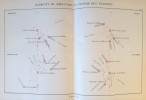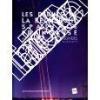-
Type
Book (4560)
Magazine (53)
Photographs (3)
-
Latest
Last month (36)
Last week (2)
-
Language
Dutch (1)
English (8)
French (4600)
German (2)
Italian (1)
Latin (3)
Swedish (1)
-
Century
16th (13)
17th (10)
18th (136)
19th (551)
20th (2381)
21st (263)
-
Countries
Belgium (335)
Côte d'Ivoire (4)
Denmark (178)
France (3839)
Italy (39)
Switzerland (221)
-
Syndicate
CLAM (4)
ILAB (2811)
NVVA (89)
SLACES (89)
SLAM (2479)
SNCAO (14)
De Mercure à Pluton : Planètes et satellites
Albin Michel. 1937. In-8. Relié cuir dos-coins. Etat d'usage, Couv. défraîchie, Dos satisfaisant, Papier jauni. 181 pages augmentées de quelques photos et schémas en noir et blanc, hors texte.. . . . Classification Dewey : 520-Astronomie et sciences connexes
"Collection ""Sciences d'aujourd'hui"". Classification Dewey : 520-Astronomie et sciences connexes"
Kosmotheoros sive de terris coelestibus, carumque ornatu, conjecturae -- TRES RARE EDITION ORIGINALE -- BON EXEMPLAIRE
La Hague, Moetjens, 1698, un volume in 4 relié en plein veau moucheté (reliure de l'époque), (petite tache brune sans gravité sur le premier plat de couverture, habiles restaurations aux coiffes et aux mors), 2pp., 144pp., 5 PLANCHES DEPLIANTES
---- TRES RARE EDITION ORIGINALE ---- BON EXEMPLAIRE ---- "THE FIRST ATTEMPT AT PHOTOMETRY" ---- "Huygens did not belive that complete certainty could be achieved in the study of nature, but thought that the philosopher must pursue the highest degree of probability of his theories. Clearly Huygens considered this degree to be adequate in the case of his explanations of light and gravity. It is difficult for the historian to assert how Huygens considered his theories about life on other planets and about the existence of beings comparable to man. The theories were expounded in his KOSMOSTHEOROS (1698). The argument of the book is very methodically set forth and its earnestness suggests that Huygens did indeed assign a very high degree of probability to these conjectures. In the Copernican world system the earth holds no privileged position among the other planets. It would therefore be unreasonable to suppose that life should be restricted to the earth alone. There must be life on the other planets and living beings endowed with reason who can contemplate the richness of the creation, since in their absence this creation would be senseless and the earth, again, would have an unreasonably privileged position... In the second part of Kosmostheoros Huygens discussed the different movements of the heavenly bodies and how they must appear to the inhabitants of the planets. He took the occasion to mention new advances in astronomy. He compared the intensity of light from various heavenly bodies - thus making the first attempt at photometry". (DSB VI p. 611)**2751/ARB3
Nouveau traité de la pluralité des mondes traduit du latin en françois par M. D*** (DUFOUR) -- PREMIERE TRADUCTION EN FRANCAIS du KOSMETHEOROS DE C. HUYGENS -- BON EXEMPLAIRE
P., Moreau, 1702, un volume in 12 relié en pleine basane, dos orné de fers dorés (reliure de l'époque), (petit accroc sans gravité à la coiffe, mouillures pâles dans les marges de quelques feuillets), (12), 277pp., 9pp., 4 PLANCHES
---- PREMIERE TRADUCTION FRANCAISE du KOSMETHEOROS de HUYGENS paru en latin en 1698 ---- BON EXEMPLAIRE ---- "Huygens did not belive that complete certainty could be achieved in the study of nature, but thought that the philosopher must pursue the highest degree of probability of his theories. Clearly Huygens considered this degree to be adequate in the case of his explanations of light and gravity. It is difficult for the historian to assert how Huygens considered his theories about life on other planets and about the existence of beings comparable to man. The theories were expounded in his KOSMETHEOROS (1698). The argument of the book is very methodically set forth and its earnestness suggests that Huygens did indeed assign a very high degree of probability to these conjectures. In the Copernican world system the earth holds no privileged position among the other planets. It would therefore be unreasonable to suppose that life should be restricted to the earth alone. There must be life on the other planets and living beings endowed with reason who can contemplate the richness of the creation, since in their absence this creation would be senseless and the earth, again, would have an unreasonably privileged position... In the second part of Kosmostheoros Huygens discussed the different movements of the heavenly bodies and how they must appear to the inhabitants of the planets. He took the occasion to mention new advances in astronomy. He compared the intensity of light from various heavenly bodies - thus making the first attempt at photometry". (DSB VI p. 611)**7994/ARB4
Nouveau traité de la pluralité des mondes. Traduit du Latin en François par M. D. ***.
A Paris, chez Jean Moreau, 1702. In-12 de (24)-277-(9) pp, 5 planches, veau brun, dos orné à nerfs, pièce de titre en maroquin rouge (reliure de l'époque).
Première édition française du Cosmotheoros sive de terris coelestibus, earumque ornatu, conjecturae, dont l'originale latine fut publiée en 1698. S'inspirant des thèses coperniciennes, Huygens développe l'idée d'autres formes de vie autour d'autres soleils. « The argument of the book is very methodically set forth and its earnestness suggests that Huygens did indeed assign a very high degree of probability to these conjectures. In the Copernican world system the earth holds no privileged position among the other planets. It would therefore be unreasonable to suppose that life should be restricted to the earth alone. There must be life on the other planets and living beings endowed with reason who can contemplate the richness of the creation, since in their absence this creation would be senseless and the earth, again, would have an unreasonably privileged position » (DSB VI, 611).Ex-libris Charles Lacour. Petit accident à une coiffe et aux coins, des rousseurs. Bon exemplaire.
Oeuvres complètes de Christiaan Huygens publiés par la Société Hollandaise des Sciences. Tome premier: Correspondance 1638-1656.
La Haye, Martinus Nijhoff, 1888, in-4to, XIV + 621 p., Frontispice (portrait de Constantijn Huijgens et ses enfants), tampon de bibliothèque sur titre, notices (additions) au crayon papier au début, dans la genealogie de la famille Huygens, brochure originale, dos fendu, jaquette abîmée.

(SLACES, NVVA)
Phone number : 41 (0)26 3223808
Images du Monde. Les mille et une façons de représenter l'Univers avant Galilée
Grand Livre du Mois Grand Livre du Mois 1999, grand In-8 relié cartonnage souple éditeur, 306 pages. Illustrations en couleurs. Très bon état
Toutes les expéditions sont faites en suivi au-dessus de 25 euros. Expédition quotidienne pour les envois simples, suivis, recommandés ou Colissimo.
Huyghe Edith ; Huyghe François-Bernard
Reference : 138702
(1999)
ISBN : 2709619245 9782709619240
Images du Monde. Les mille et une façons de représenter l’Univers avant Galilée
JC Lattès 1999 In-8 broché 24 cm sur 18. 299 pages. Bon état d’occasion.
Bon état d’occasion
LE MONDE MERVEILLEUX A VENIR
AMBASSADOR COLLEGE. 1968. In-12. Broché. Bon état, Couv. convenable, Dos satisfaisant, Intérieur frais. 126 pages illustrées de nombreuses photographies en noir et blanc et en couleurs hors texte.. . . . Classification Dewey : 520-Astronomie et sciences connexes
Classification Dewey : 520-Astronomie et sciences connexes
L'Astronomie. Texte établi et traduit par André Le Boeuffle.
1983 Paris, Belles Lettres, 1983, in 8°, reliure de l'éditeur, LXXVIII-235 pages, dont 2 fois de 1 à 148 ; 5 figures hors-texte et 2 planches dépliantes.
Texte et traduction. ...................... Photos sur demande ..........................


Phone number : 04 77 32 63 69
Fabularum liber ad omnium poetarum lectionem miré necessarius & nunc denuo excusus. Eius dem poeticon Astronamicon Libri quatuor, quibus accesserunf similis argumenti, Palaephati De fabulosis narrationibus Liber I ; Fulgenti Placiadis episcopi Carthaginensis Mythologiarum Libri III ; Eiusdem De vocum antiquarum interprettione Liber I ; Phornuti De natura deorum sine poeticarum fabularum allegoriis speculatio ; Albrici Philosophi De deorum imaginibus Liber ; Arati Fraetu, germanico caesare interprete ; Procli De sphaera libellus, Graece & Latine... Index refum sententiarum & fabularum in his omnibus scitu dignarum, copiosissimus -- BON EXEMPLAIRE
P., Gulielmum Iulianum, 1578, un volume in 8 relié en pleine basane, tranches rouges (reliure de l'époque), (mouillures pâles sans gravité à quelques feuillets à la fin du volume, cachet de bibliothèque sur la page de titre), 8 feuillets non chiffrés, 317 feuillets chiffrés (634pp.), 58 feuillets non chiffrés, bois gravés dans le texte
---- BON EXEMPLAIRE ---- Quatrième édition ornée de bois gravés dans le texte représentant des constellations ---- Edition inconnue de Brunet**2752/ARB3
Astrophysics a topical symposium commemorating the fiftieth anniversary of the yerkes observatory and a half century of progress in astrophysics
McGraw - Hill book company. 1951. In-8. Relié. Très bon état, Couv. convenable, Dos satisfaisant, Intérieur frais. 703 pages.. . . . Classification Dewey : 520-Astronomie et sciences connexes
Etiquette sur coiffe en pied. Tampon bibliothèque. Texte écrit en anglais. Classification Dewey : 520-Astronomie et sciences connexes
L'astronomie et la météorologie récréatives, d'après Lalande, Herschell, MM. Arago, Ajasson de Grandsagne, Cournot, etc. Ouvrage renfermant, outre les élémens de la science, des anecdotes, des problèmes amusants et propres à rendre l'étude de ces deux sciences agréable et facile.
Paris, B. Renault 1835. 8°. 270 S. Mit einer mehrfach gefalteten, lithographierten Tafel als Frontispiz 4 lithographierten Tafeln. Pappband der Zeit mit handschriftlichem Rückentitel.
Hübsche kleine Vulgarisation. - Frontispiz mit kleinem Einriss. Schwach stockfleckig.
Premières notions de cosmographie
Delagrave. Non daté. In-12. Cartonné. Bon état, Couv. convenable, Dos satisfaisant, Intérieur frais. 152 pages. Annotations à l'encre sur le premier contreplat et en page de garde.. . . . Classification Dewey : 520-Astronomie et sciences connexes
Classification Dewey : 520-Astronomie et sciences connexes
Über die Entstehung der Phaenomena des Endoros-Aratos. ‘Beil. z. Jahresber. d. königl. Wilh.-Gymn. zu Emden’.
Emden, Hahn, 1905, in-8vo, 37 S. + 3 Tafeln, Broschüre ohne Umschl.

(SLACES, NVVA)
Phone number : 41 (0)26 3223808
Commentarius in m. Manilii astronomica - Verhandelingen der koninklije akademie van wetenschappen te Amsterdame - afdeeling letterkunde nieuwe reeks
Koninklije akademie van wetenschappen te Amsterdam 1921 in4. 1921. Broché.
couverture défraîchie salie rousseurs tranche ternie bords frottés pages non coupées intérieur globalement propre qques rousseurs légères documentation dépliante détachée de la brochure du livre in-fine
Le grand livre de l'espace
Grund. 1989. In-Folio. Cartonné. Etat d'usage, Coins frottés, Dos abîmé, Intérieur acceptable. 10 pages cartonnées illustrées en couleurs dans le texte - quelques manques superficiels dans le texte pouvant légèrement altérer la lecture - coiffes abimées, frottées - traces et adhésif dans le texte - dimensions, environ 40 x 60 cm. . . . Classification Dewey : 520-Astronomie et sciences connexes
Classification Dewey : 520-Astronomie et sciences connexes
JONCTION GEODESIQUE ET ASTRONOMIQUE DE L'ALGERIE AVEC L'ESPAGNE
Jonction géodésique et astronomique de l'Algérie avec l'Espagne, exécutée en commun en 1879, par ordre des gouvernements d'espagne et de France, sous la direction du Général Ibanez et du Colonel Perrier. In 4° ( 266 x 213 mm), page de titre, XIX -281 pp, 1 carte noir et blanc, 7 planches doubles, planches, 1 planche double couleurs, reliure demi chagrin, dos à nerfs.
LES CONQUERANTS DU CIEL ET DE L'ESPACE
HACHETTE. 1973. In-8. Relié. Bon état, Couv. convenable, Dos satisfaisant, Intérieur frais. 153 pages - nombreuses photos et illustrations en noir et blanc et en couleurs dans et hors texte - plats illustrés en couleurs.. . . . Classification Dewey : 520-Astronomie et sciences connexes
ILLUSTRATIONS DE JACQUES POIRIER Classification Dewey : 520-Astronomie et sciences connexes
AU COMMENCEMENT DU TEMPS
FLAMMARION. 2009. In-8. Broché. Bon état, Couv. convenable, Dos satisfaisant, Intérieur frais. 317 pages. Premier plat illustré en couleurs.. . . . Classification Dewey : 520-Astronomie et sciences connexes
Classification Dewey : 520-Astronomie et sciences connexes
Navigation, volume XXX, n°119
Rédaction du journal. 1982. In-8. Broché. Bon état, Couv. convenable, Dos satisfaisant, Intérieur frais. Revue trimestriell d'une centaine de pages. avce quelques figures et des cartes.. . . . Classification Dewey : 520-Astronomie et sciences connexes
Revue technique de navigation maritime, aérienne et spatiale. Classification Dewey : 520-Astronomie et sciences connexes
Les débuts de la recherche spatiale française. Au temps des fusées-sondes
E-dite 2007 In-4 cartonné, 398 pp, nombreuses illustrations en noir.
Aventure humaine exceptionnelle, faite de défits techniques et scientifiques, de difficultés innombrables, mais aussi d’espoirs et d’émotions que seuls les acteurs de l’époque pouvaient décrire. Très bon état d’occasion
Astronomiae Pars Optica Traditur
Bruxelles 1968 Culture et Civilisation Full-Leather (Hardcover)
Reliure en cuir pleine, le dos décoré du titre et de l'année dans un cadre rouge foncé avec impression dorée, Facsimile - 1604 , 23 x 19 cm, 449 + index pp., français, illustrations, état du livre: Très bon.
PLUS QUE DE SIMPLES TERRIENS - LECONS DE L'ESPACE - COLLECTION EBV.
BRUNNEN VERLAG BALE / R.BROCKHAUS VERLAG. 1984. In-8. Broché. Bon état, Couv. convenable, Dos satisfaisant, Intérieur frais. 111 pages - annotation sur la page de faux titre - quelques illustrations en noir et blanc hors texte.. . . . Classification Dewey : 520-Astronomie et sciences connexes
COLLECTION EBV. Classification Dewey : 520-Astronomie et sciences connexes
GUIDE DE LA COMETE DE HALLEY ET LE PHENOMENE MYSTERIEUX DES COMETES
EDITIONS DU ROCHER. 1985. In-8. Cartonnage d'éditeurs. Bon état, Couv. convenable, Dos satisfaisant, Intérieur frais. 123 pages. Nombreuses illustrations en noir et bland, dans le texte et hors texte.. . . . Classification Dewey : 520-Astronomie et sciences connexes
Classification Dewey : 520-Astronomie et sciences connexes
LA COMETE DE HALLEY
FRANCE LOISIRS. 1985. In-12. Cartonnage d'éditeurs. Bon état, Couv. convenable, Dos satisfaisant, Intérieur frais. 123 pages, nombreuses illustrations dans le texte, frontispice. Ecriture sur la page de faux titre.. . . . Classification Dewey : 520-Astronomie et sciences connexes
Traduit de l'américain par Paul couturiau. Classification Dewey : 520-Astronomie et sciences connexes
 Write to the booksellers
Write to the booksellers















